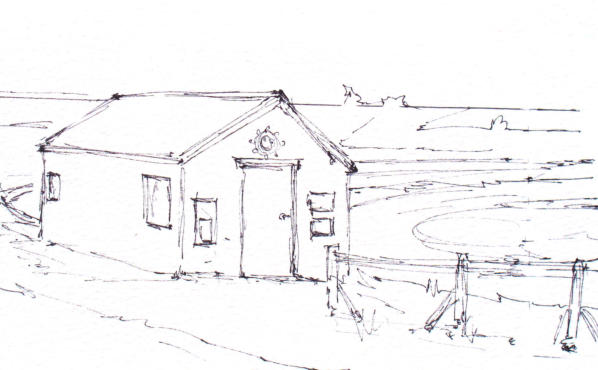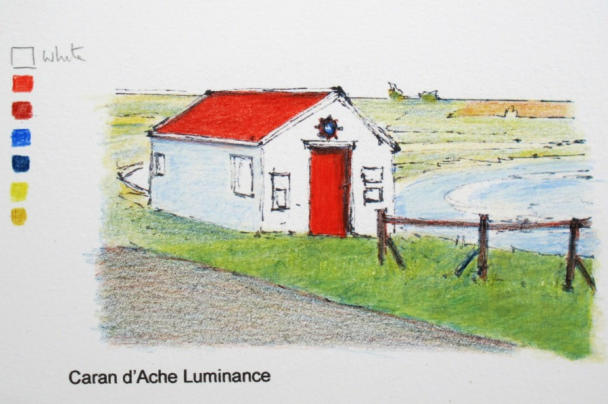- Home
- Colour Theory
- Limited color palette challenge
Limited color palette challenge
As a colored pencil artist you might discover that sometimes setting certain boundaries can spur remarkable creativity and growth.
Imagine this: you're tasked with taking on a limited color palette challenge using only six colored pencils to breathe life into a small landscape drawing.
Suddenly, the limited options push you into a corner, compelling you to think more critically about your choices and to explore innovative ways to achieve the effects you desire.
The Power of Constraints
Challenges can seem daunting, especially when you are restrained by a limited color palette.
Limitations? They're actually opportunities!
They encourage you to be intentional with your color choices and to carefully consider how each hue will contribute to the overall composition.
The power of constraint lies in its ability to push you beyond your comfort zone, and allow you to discover new possibilities within the boundaries you have set for yourself.
These boundaries could be financial. After all, embracing your artistic flair shouldn't mean having to empty your pockets. If you're dabbling with a new medium for the first time, it's wise to explore what's achievable with a small investment.
You might be surprised at the magic you can create without breaking the bank!
The challenge photo
Your mission should you choose to accept it, is to recreate this photo of a seaside hut. To get you started we have simplified the process for you by providing a sketch.
I'm sure you'll notice the curious absence of the cluster of antique machinery on the right in the sketch below. You're not wrong—it's missing on purpose! You see, this isn't just about creating a picturesque piece of art, but rather, an intentional limited colour palette challenge. It's all about the art of omission and focusing on the essential elements.
But don't worry, I haven't stripped the scene of all its charm. I've added a few intriguing dark posts in the foreground, creating depth and a sense of mystery.
I've also nudged the roofline just a tad higher than the skyline. It's all in the name of keeping my compositional eye, and hopefully yours, too, happy.


Your limited color palette contains...
The six colors we will use for this challenge are primary colours - two red, two yellow and two blue. It would be helpful if pencil manufacturers would supply this selection in a small tin, however their idea of useful colors to include in a set can be a bit baffling at times.
Therefore, you will need to buy these pencils individually if you don't already have them to hand. This does give you the opportunity of ensuring that the ones you use all have good lightfastness ratings.
The pencils used for the example here are Caran d’Ache Luminance. These lightfast pencils with a high wax content have a soft touch and handle smoothly on the 300gsm hot pressed surface. Those chosen were...
- Permanent Red 061
- Russet 065
- Middle Cobalt Blue 660
- Prussian Blue 159
- Bismuth Yellow 810
- Yellow Ochre 04
I also added a White 001 for blending purposes.
If you want to replace these with a more economical brand try to pick colors as close to those given as possible.
No greens?
You will note a profusion of lush, vibrant greens in the photo, but our palette does not include a single green pencil! We will create our own by layering the other colors and fooling our eyes into believing they are seeing green.
We won't use a black pencil either. Just saying...
How I use the limited color palette
The photos below show my process for tackling this limited color palette challenge. I tend to work over the whole drawing, but the steps below take each element at a time.
The building
I start with several light layers of Permanent Red on the roof, then add Russet and Prussian Blue to the edges for shadow.
I apply White to the shadowed wall (leaving the lighter wall bare paper). With a very light hand I add a touch of Cobalt Blue into the white. This will need smoothing out with a further layer of White.

The door
With the precision of sharply pointed pencils, I add some depth to the picture by crafting the wheel above the door using Prussian Blue and Russet. Then I add just a touch, a hint, a smidgeon of White to create the highlight.
The real magic starts now: it's time to add shadows. Applying Prussian blue to the door edges is my secret ingredient here. This step will allow me to achieve a beautifully dark shadow.
To complete the door, I use Permanent Red pigment. But not just one layer - oh no, it needs three! These thin layers, worked across each other, ensure a smooth, even application that enhances the depth of color.
Next, I bring in the magic - the white pencil. This might seem a bit unusual, but trust me on this - the white pencil is a game-changer. I use it to burnish the red, pressing the color into the paper. This not only solidifies the color but also gives it a certain vibrancy that stands out.
Lastly, I add a top layer of red over the door surface. This acts as a final touch, enhancing the red finish and giving it a strong, yet even look. The result? A rich, deep, and compelling red door that takes your breath away.
To learn more about burnishing colored pencil click this link.
The green areas

After studying the green areas I start with the foreground grass. This is a great strategy as it helps to understand how the green hues will evolve from the colors in our limited color palette.
I decide that alternating light layers of Prussian Blue and Yellow Ochre will ensure that the shading doesn't end up featureless.
One technique I use is to withhold the dark yellow from the shadowed area beside the hut, letting it emerge nearly blue. Repeating this along the edge of the grass nearest to the viewer helps to give depth to the verge so it appears to be raised off the road surface.
I continue to work very light layers over the foreground grass and then burnish with White, (see the section below the door) and then finally work back over the area with the Prussian Blue and Yellow Ochre again (see the right hand side).
For the lighter green hillside in the distance I use the Middle Cobalt Blue and Bismuth Yellow in uneven layers. In some areas I leave just the light yellow showing, and in others I add some Yellow Ochre, to give variation.
The posts, road and water
For the dark posts I alternately layer the Russet over the Prussian Blue (three layers of each).
The water has a base of White to protect the paper surface from being stained by the more saturated Cobalt Blue on top. White over that smooths it out.
Finally the road consists of light layers of all six colors, worked in succession. This is left unburnished so that the grain of the paper still shows to represent the road texture.
Challenge achieved?
I sincerely hope you've tried your hand at this limited color palette challenge!
You'll find that the experience is much more immersive and rewarding when you're not just passively reading through my instructions, but actively applying them.
It's one thing to read about blending colors, but it's a completely different experience when you witness the magic unfold right in front of your eyes. As you watch the colors merge and mix, the technique truly sinks in and becomes part of your artistic arsenal. The next time you're faced with a blank piece of paper and a set of colored pencils, you'll instinctively know how to use this skill.
Remember, it's not just about comprehending the steps, but truly internalizing the lessons. So, grab those pencils and dive right into the challenge. The beauty of art is in the doing, and I can't wait for you to experience it! Let's get those creative juices flowing and release the power of the limited color palette!
Have you tried this challenge?
Tell us how you got on and share your finished artwork.

